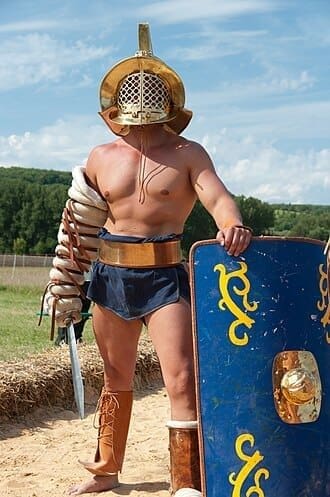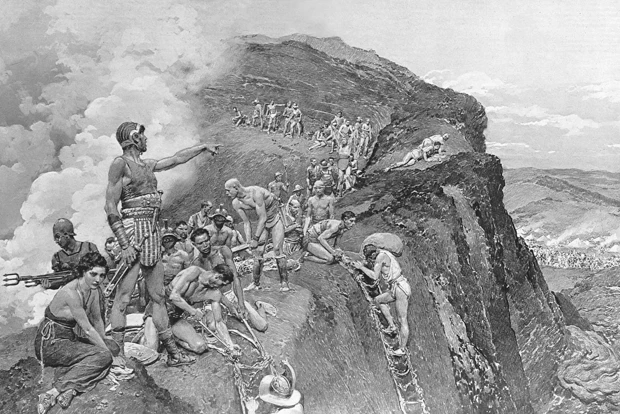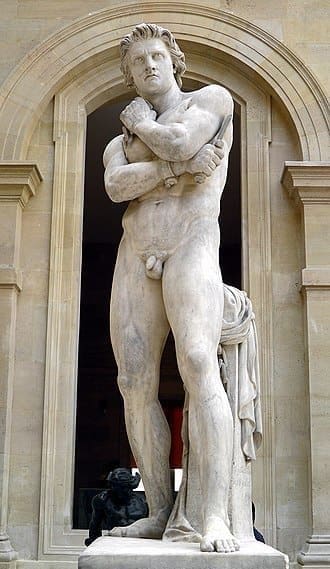A gladiator trained to die for sport nearly brought Rome to its knees.
Most of us know Spartacus as the shirtless warrior from movies, roaring into battle with righteous rage. But strip away the Hollywood glare, and you’re left with something even more gripping — the real Spartacus.
A Thracian warrior. A slave. A tactician who nearly outplayed the Roman war machine.
This is the story of a man who wasn’t supposed to lead — or even survive — but who instead carved his name into the heart of Roman history.
Let’s look into the true story of Spartacus and how he shook the Roman Empire to its core.
Who Was Spartacus?
Spartacus was likely born in Thrace (modern-day Bulgaria or nearby), a region known for fierce warriors. This region was named after Thrax, Ares’ son (yes, the god of war himself), who was believed to have resided there.

Little is known about his early life, but historians believe that he served as a soldier in the Roman military before being enslaved, either for desertion or inciting a rebellion. He’s always been a force of nature like that.
Captured and sold, Spartacus was brought to the gladiator training school in Capua in 73 BCE. There, he was groomed to die for the entertainment of Roman crowds. But instead of breaking, he watched.
He learned.
And eventually, he resisted.
His background gave him a unique edge. Spartacus understood Roman tactics. He also understood pain, oppression, and what it meant to fight without a future.
That alone made him an undeniable threat to the empire.
Life as a Gladiator
Let’s take a step back for a bit and look at his time as a gladiator.
Life in a ludus (gladiator school) was brutal.
Gladiators were slaves trained to fight, sometimes to the death, in front of cheering crowds. They lived in cramped conditions, under constant surveillance, pushed to physical limits every day.
Spartacus fought as a heavyweight gladiator known as a murmillo, carrying a large oblong shield (scutum) and wielding an 18-inch sword (gladius) with a broad, straight blade.

Gladiator schools were filled with strong men who had nothing to lose, the perfect spark for revolution.
In Roman society, gladiators were both despised and admired. They were slaves and objects for entertainment, after all.
This made Spartacus’s rebellion even more symbolic. He turned Rome’s spectacle of violence into a battlefield of resistance.
It’s no surprise, then, that the first swing of his rebellion came from within those very walls.
The Gladiator Rebellion Begins
Spartacus and around 70 fellow gladiators escaped from the school in Capua. Though small in number, they grabbed kitchen utensils, fought their way out of the school, and captured several wagons filled with gladiatorial weapons and armor.
They defeated the soldiers sent to stop them, raided the area around Capua, recruited many more slaves, and eventually retreated to a stronger defensive position on Mount Vesuvius.
At one point during the chase, a Roman praetor named Glaber gathered a militia and trapped Spartacus’ group on Mount Vesuvius. They blocked the only known exit and waited for hunger to force their surrender.
But Spartacus led his men in crafting ropes and ladders from vines and trees. They scaled down the opposite side of the mountain, circled, and surprised Glaber’s forces, defeating them despite lacking formal military training.

What started as a jailbreak turned into a growing movement.
Spartacus helped shape them into more than fugitives. They became an army; scrappy, scattered, but with purpose.
It was no longer just about freedom.
It was war.
The War Against Rome (The Third Servile War)
Unpopular opinion: Spartacus belongs to the list of history’s most brilliant military minds alongside Alexander the Great.
He was no Roman general. But somehow, he outmaneuvered the very people who once trained him. His battles against Roman praetors and consuls weren’t mere lucky wins; they were tactical slaps in the face to Roman pride.
His meager band of 70 gladiators turned into an army of 90,000 men.
But his military prowess isn’t only shown in his leadership but also in his tactical brilliance.
The Roman Empire had completely underestimated Spartacus.
Spartacus and his army of slaves-turned-soldiers continued resisting against Roman offensives and marched as far north as the Alps.
Rome eventually sent Crassus, one of its wealthiest citizens, to crush the rebellion. When Pompey later joined the effort, the trap closed.
Spartacus and his army were surrounded.
Fall and Legacy
With his army trapped by Crassus’ forces, Spartacus decided to stand his ground one last time. In the decisive Battle of the Silarius River, Spartacus and his men faced the Roman legion on the open field.
The gladiators charged the Roman lines, slamming into a wall of shields and swords. They fought fiercely and killed many Roman soldiers, but suffered heavy losses themselves.
Soon, the Roman legion overpowered them.
Spartacus was killed in battle.

In the aftermath of the war, Rome crucified 6,000 of his followers along the Appian Way. A cruel, public reminder that rebellion comes at a price.
But Spartacus didn’t die in vain.
His actions led Rome to rethink its slave economy and its internal security.
He became more than just another name in the long list of Roman history’s extraordinary gladiators.
He became a symbol for revolution,
for the enslaved,
for anyone pushed to fight back when there’s no other choice.
Spartacus’ Legacy in Roman History
Spartacus wasn’t fighting for glory in the arena. He was fighting to break the chains around his neck — and the necks of thousands more.
He wasn’t supposed to be remembered. But he is.
Not because he won, but because he tried.
And because, for a moment, he made the most powerful empire in the world feel afraid.
Centuries later, his story inspired writers, rebels, and filmmakers. From Karl Marx to Stanley Kubrick, Spartacus became shorthand for righteous defiance.
To date, his name still stirs something primal: the idea that one voice, even a silenced one, can change the course of history.
SOURCES:





0 Comments